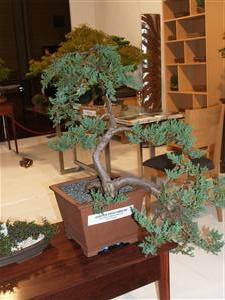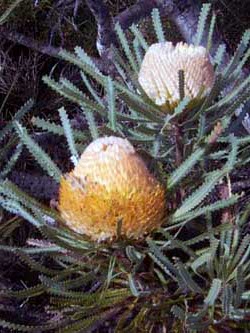Potting Up
 HOW TO POT A PLANT
HOW TO POT A PLANT
If you leave a potted plant with the same growing medium for too long, the plant will begin to suffer. This principle is true of newly germinated seedlings as well as established container-grown plants. Likewise, potting up plants can lead to improved plant health or vigour.
Plants are potted for a number of reasons:
-
They are getting too big in the pot they are in and need more room to grow.
-
You want them to grow at a faster rate to produce a larger plant in less time.
-
You want the plant in a different container – to replace a broken pot, or use one that looks better or is more functional.
-
You want to root prune the plant. This promotes the development of new healthy feeder roots. Root pruning may also be undertaken to remove diseased roots.
-
You want to put the plant into a better growing medium.
-
You want to re-pot a bonsai, topiary or specially shaped plant.
-
You want to transplant plants from an in-ground location into a pot.
Potting a small plant into a larger pot
When you start seeing roots emerge from the bottom of your pot plant, it’s time to repot into a larger container. Select a pot that is slightly larger, but not too much bigger.
Gently remove the plant from the smaller pot. If the plant will not come out easily, slide an old kitchen knife around the edges of the pot. If it will still not come out, you may have to break or cut the pot.
-
Loosen any tangled and circling roots. Prune the roots if necessary.
-
Place a layer of quality potting mix at the base of the new pot.
-
Place the plant in the centre of the new pot. The soil level should be approximately 25 mm (1 inch) below the top of the container.
-
Fill the sides of the container with potting mix, firming it down as you go.
-
Thoroughly water the pot. This will help remove any air pockets.
-
Cut back any dead or diseased foliage and prune to shape.
-
Apply a slow release fertiliser.
Digging plants out of soil and transplanting into pots
-
Well before you are ready to transplant, dig a trench the size of the pot around the plant. This will sever any roots that won’t fit into the pot and reduce transplant shock.
-
One or two days before removal thoroughly water the root zone. This will help bind the soil together.
-
Prepare the container you are going to use. Place a layer of standard potting mix at the bottom.
-
Dig around the plant, taking as much soil and roots as possible.
-
If the soil is crumbly, slide a plastic or hessian bag underneath to bind the root ball together when you move it to the pot.
-
Place the plant in the pot, backfill with potting mix and water well.
Potting up a hanging basket
Hanging baskets are prone to drying out because they are up high, exposed to drying winds. They tend to be smaller and shallower than other pots, which means they hold less soil and water. And often it’s simply a matter that they’re not watered enough because they’re too hard to get at.
- Use small plants, preferably ones that are easy to replace as soon as they go off (eg. annuals).
- For a wire basket, line the basket with sphagnum moss or use a fibre liner.
- Half-fill the basket with potting mix specially designed for hanging baskets. These mixes contain water crystals so if you use an ordinary mix, be sure to add your own water crystals.
- Take the plant(s) out the pot(s) and place in the basket. Small plants (preferably with trailing stems) can also be planted into the sphagnum moss in the sides of the basket.
- Cover the roots with soil and water thoroughly.
- Cover the basket surface with fine bark mulch to help keep the moisture in.
- Water daily throughout warm weather and pinch back any leggy, vigorous growth.
Potting Bedding Plant Seedlings
In a commercial nursery, bedding plants are annuals that are germinated in a hot house out of season, then potted up at seedling stage and sold at bud stage ready to plant out and provide mass colour. At the end of the season they are discarded.
Bedding plant seed is sown in late winter and maintained at a temperature of around 20-22°C. When the first set of true leaves are open the seedlings should be pricked out and planted into cell trays filled with a good quality seedling-raising mixture. Handle the seedlings by the leaves and not by the stems. The seedlings should be well watered and kept in the shade for the first 3-5 days at a reduced temperature of 15°C.
 Potting Trees and Shrubs
Potting Trees and Shrubs
Trees and shrubs can be potted at most times of the year, ideally when the plant is actively growing. Be aware that there may be some transplant shock, and a recovery period will be required afterwards. Potting can cause flower bud drop. If you want flowers, it is best to wait until flowering has finished before re-potting. If you pot in summer, the plant may suffer from water stress and will need to be closely watched for at least a few days. You may be better to wait until after warm weather.
-
Don't pot up in windy or sunny places - drying of plant roots can occur very rapidly.
-
Pot in a clean place (a clean shed or on a washed concrete base) to minimise disease problems.
-
Don't pot on a very hot day.
-
Put plants into a cool protected position for at least a few weeks after potting.
Potting Bare-rooted Plants
Juvenile and semi-advanced plants from in-ground nurseries are frequently lifted for transplanting in a bare-rooted state. This includes, in particular, many deciduous plants such as grafted fruit trees, ornamental trees and roses. Bare-rooted plants are most frequently sold for planting directly in-ground, but can also be suitable for transplanting into pots.
These are lifted predominantly when the plant is in a dormant state during mid to late winter, when the plants will suffer minimal transplant shock. Plants can be inspected at this stage and those with diseased or damaged roots can be discarded or root pruned. Plants with large root systems are sometimes pruned to promote ease of handling (eg. transporting, replanting). Plants that are to be replanted fairly quickly can be easily bunched together in bundles of ten or more to assist ease of handling. Those plants that are to have an indefinite time before replanting (eg. plants sold to retail nurseries) should have their roots protected in some way to prevent them drying out. Materials such as moist sawdust can be packed around the roots to provide temporary protection. Bare-rooted plants are often kept in refrigerated storage until planting time.
-
Potting up bare-rooted plants is a reasonably simple procedure, but some care needs to be taken.
-
Roots should be soaked before potting.
-
Following initial plant manicuring, roots should not be pruned before re-planting (diseased tissues should, however, be removed).
-
Care must be taken when fertilising bare rooted plants to avoid damaging new root growth.
-
Newly potted bare-rooted plants should be kept moist and protected.
Porous pots need different treatment
Some pots (eg. wood or terracotta) dry out more easily than others, because they soak up moisture from the potting mix. These pots can be attractive sales features, and may suit some plants that like dry conditions, but they can be problematic with plants that require moist soil. Some particular management techniques can assist in achieving pleasing results with porous pots:
- Use a potting mix specially designed for terracotta pots – these have materials added that retain water for longer.
- Add peat to the potting mix (soak the peat first so that it can absorb water).
- Add water crystals to the mix.
- Cover the surface of the mix with mulch (small pebbles or a fine bark mulch).
- Avoid using porous pots in positions where they will be exposed to high levels of solar radiation, winds, or other evaporative elements
You may also be interested in....
The Ultimate course for Home Gardeners - Be the "expert" in your family, or with your friends.
View Course
Exceptional training for a serious business or career -lots of different options to specialize.
View Course